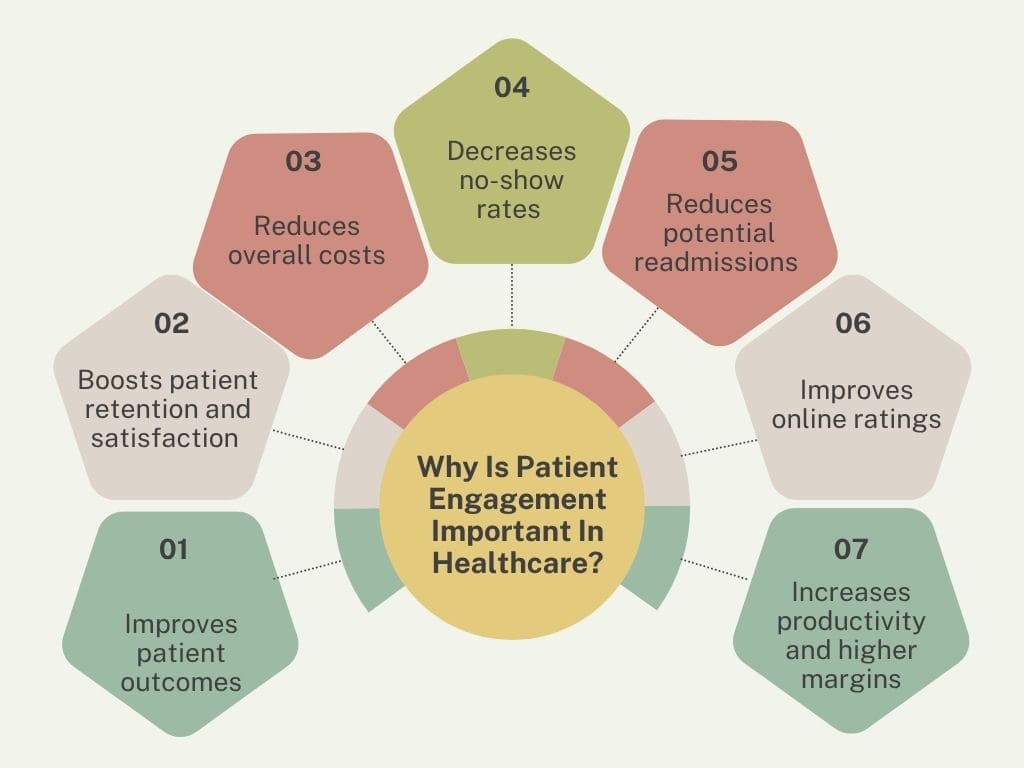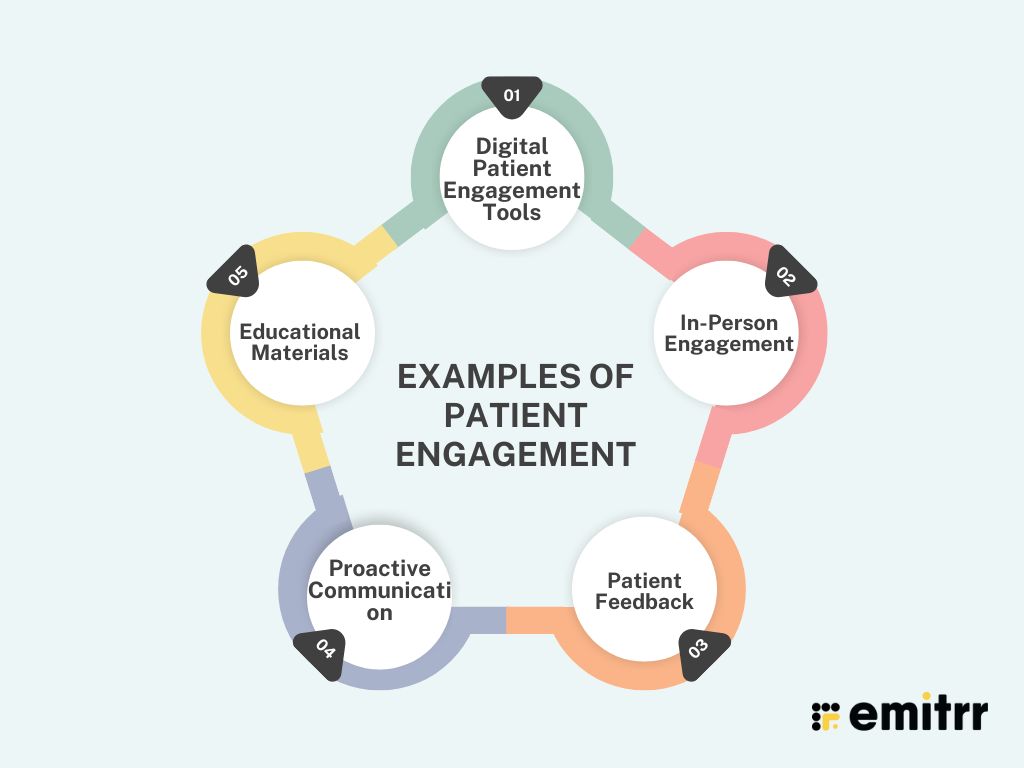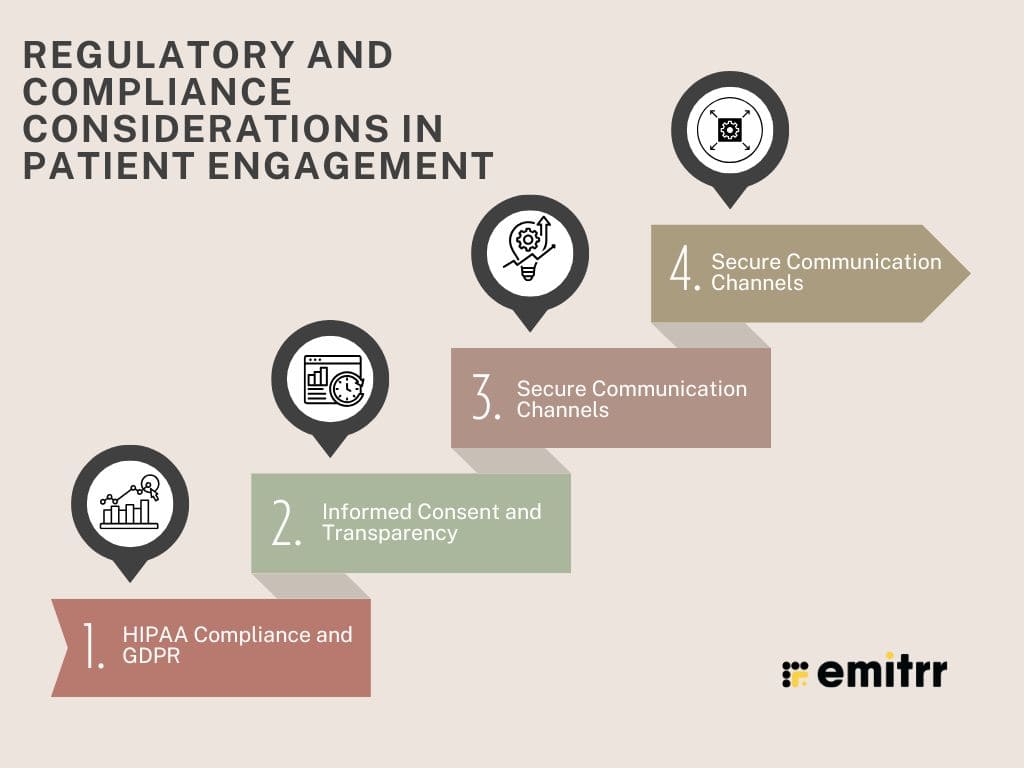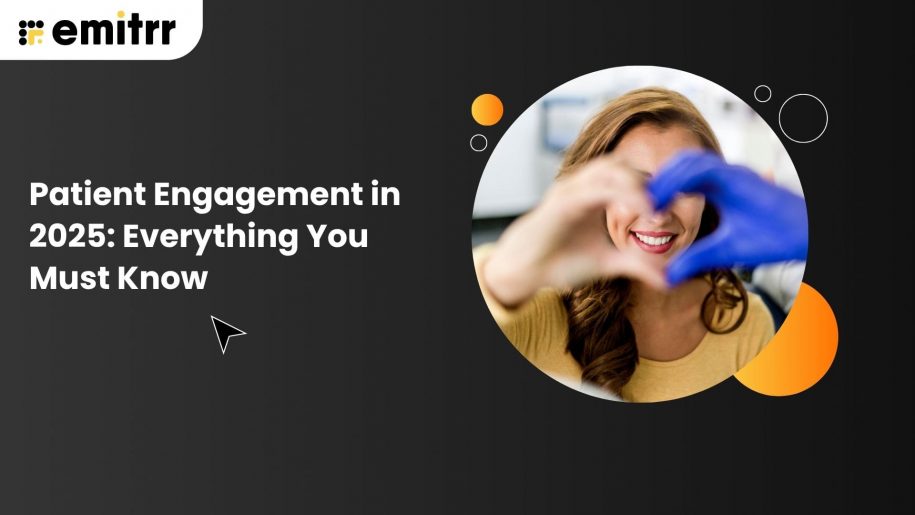Introduction
Patient engagement is the extent to which patients become actively involved in their healthcare journey. To build and nurture engagement with patients, healthcare practitioners need to deploy strategies that encourage patients to make informed decisions with respect to their overall health and well-being.

With the healthcare industry becoming more patient-centered, healthcare professionals need to deliver personalized care, thereby improving overall patient experience.
If you are a healthcare professional desperately looking for answers to improving patient engagement; this is your go-to guide! Explore the importance and benefits of patient engagement, the trends governing patient interaction, the challenges faced by healthcare professionals, and some actionable strategies to implement to boost patient communication.
What Is Patient Engagement?
Patient engagement is the process of involving patients in their overall healthcare journey. It includes connecting with patients at various touchpoints across their journey and providing personalized care.
A strong focus on patient communication leads to improved health outcomes, higher patient satisfaction, reduced costs, and an improved clinician experience. In this dynamic environment, it’s crucial for healthcare providers to keep their patients connected by focusing on sharing information, taking responsibility, and ensuring a comprehensive approach to patient involvement.
Prioritizing engagement of patients in your healthcare practice is essential for offering improved assistance to your patients. Essentially, patient communication and engagement is the way healthcare providers structure their interactions with patients to achieve more favorable outcomes.
What is the Importance of Patient Engagement In Healthcare?
Right from reducing overall costs to improving patient outcomes, patient engagement plays a very important role. Let us have a look at the importance of patient engagement in healthcare:

Improves patient outcomes
Patient engagement is crucial for fostering a proactive healthcare environment. It not only strengthens the doctor-patient relationship but also empowers individuals to actively participate in their own well-being. By promoting communication, understanding, and collaboration, healthcare engagement plays a pivotal role in improving overall health outcomes.
Boosts patient retention and satisfaction
When a patient is constantly motivated and empowered to actively participate in their healthcare process and make informed decisions about their health, they develop trust with the provider. Patient interaction leads to a strong connection, making patients feel that the healthcare provider genuinely cares. This not only helps in preventing missed appointments but also contributes to higher retention rates.
Reduces overall costs
One of the key benefits of patient engagement is cost reduction. Engaging with patients using a patient engagement system and technology can be cost-effective. Partnering with the right technology can help efficiently manage tasks at scale, reducing resource costs. With a proper patient engagement strategy in place, the staff can save 3-4 hours of daily time and focus on other important tasks at hand.
Decreases no-show rates
$150,000,000,000. This is the cost that healthcare organizations bear every year as a result of missed appointments. Nearly one-third of patients don’t show up for their appointments because they simply forgot. As a healthcare practitioner, it is important to keep your patients engaged even before they visit you. This includes sending them appointment reminders to ensure that they do not miss out on their appointments.
Reduces potential readmissions
Engaged patients are more likely to get frequent health checkups, constantly follow up with their providers, and develop preventive behavior to ensure better overall health. When they take care of themselves and actively engage in improving their well-being, they will avoid any readmissions or intense intervention from the provider.
Improves online ratings
If your patients are engaged, they will post feedback about the service. Reviews and ratings give a facelift to the brand and shape how others perceive it. If your patients are engaged, they will mention how the process of connecting with the doctor, booking an appointment, and availing of treatment was effortless. This will create credibility around the clinic and ensure quality relationships are built.
Even before choosing a restaurant, customers go through reviews on Google, Yelp, and other platforms. For an aspect as important as healthcare, the amount of scrutiny taken by a consumer/patient is even more, which is why healthcare engagement is important for you to focus on.
Increases productivity and higher margins
If employees are able to smartly get all the patient information in an automated fashion, their work is simpler. This improves their productivity. Clinics and healthcare practitioners with better engagement strategies have higher profit margins. This is because patients who are connected, in time, have all their digital records and enjoy a seamless process. This can be noticed in this study by NCBI, where it was observed that patient engagement and patient satisfaction provided great results. It was also noticed that the program led to improved productivity, employee satisfaction, and overall recognition.

Key Aspects of Patient Engagement
Patient engagement plays a key role in involving the patient in their own care to improve patient outcomes. Some key aspects of patient engagement are health literacy, effective communication, technology integration, and more. Let us discuss these key aspects in detail:
- Effective communication: This includes clear, open, and concise communication between doctors and patients to help patients feel heard and to boost their trust.
- Patient Activation: This includes educating patients with the right skills and knowledge so that they feel confident about taking charge of their own health.
- Active Participation: This involves encouraging patients to make informed decisions related to their health, actively managing their condition, adhering to treatment plans, and positively collaborating with their healthcare providers in treatment planning.
- Health literacy: Patients should understand their health condition, possible treatment options, the importance of adherence, and expected healthcare outcomes.
- Use of Technology: Patients should be introduced to digital patient tools like automated communication platforms, telehealth, and remote monitoring, mobile apps, etc., for better patient communication.
- Shared decision-making: This involves actively involving patients in creating or selecting the right treatment plan and allowing them to make decisions pertaining to their own health.
Patient Engagement Examples
From in-person interaction to utilizing digital channels, there are many ways to engage with patients. Let us take a look at the most popular patient engagement examples in healthcare:

Digital Patient Engagement Tools
Digital patient engagement tools are being used by many healthcare practitioners today. Be it using patient portals to view test results, request refills, schedule appointments, get virtual consultations, or use automated texts or emails to remind patients of upcoming visits. Digital tools are great examples of patient engagement.
We recommend you check out Emitrr– a complete digital patient engagement tool that is being used by many healthcare practitioners.
In-Person Engagement
This involves engaging with patients in person by either organizing in-person support groups and communities, inviting family members to care, planning discussions, or simply making the patient feel heard and cared for.
Patient Feedback
This involves gathering insights via patient satisfaction surveys or feedback forms to improve patient care or keeping suggestion boxes and encouraging patients to share ideas and concerns anonymously. If you cannot install digital patient engagement tools, then this could be a great channel for improving engagement with patients.
Proactive Communication
Being proactive while communicating with patients is a great example of patient engagement. This includes sending follow-up messages after hospital discharge, sending prescription or medication reminders, and automating regular messages for patients with chronic health conditions such as diabetes, hypertension, etc.
Educational Materials
Another good example of patient engagement is by focusing on patient education. For this, you can think of sending handouts, videos, or links that explain conditions and treatments in plain language or handout printed decision aids that help patients weigh risks and benefits of different treatments.
Key Trends Influencing Patient Engagement in Healthcare
The way doctors used to engage with their patients has evolved completely; so, what are the current trends that are influencing patient engagement? Here’s a look:
Deeper doctor-patient communication
One of the major trends that have emerged over the past few years is the constant focus on strengthening doctor-patient communication. With the healthcare industry becoming more consumer-centric, patients are being presented with personalized services that meet their needs. The drive to deliver a good patient experience is urging providers to ensure smooth communication with patients.
Digitization of patient engagement
Digital health patient engagement is undoubtedly the future of the healthcare industry and is here to stay. The rising focus on technology and its rapid penetration in the healthcare industry has opened doors for growth for all healthcare organizations, as it helps reduce any operational inefficiencies and healthcare costs. Digitization is important to encourage deeper doctor-patient relationships and increased patient satisfaction levels.
Rising omnichannel momentum
Omnichannel healthcare has become a vital part of healthcare communication and patient interaction. Patients need transparency in care, on-demand and personalized healthcare, and real-time support. Omnichannel healthcare is fulfilling all these patient needs by allowing patients to gain more control over their health outcomes. Not only that, it has helped providers restructure and streamline their workflows.
Rising focus on health education
Patients have now become more interested in their health and want to be upfront with every bit of information about their health. Owing to this increasing inclination, it is important for healthcare providers to keep their patients engaged by equipping them with the necessary information about their health, including their conditions, diagnosis, and medical treatment plans.
Active adoption of self-care
Patients have now taken control of the steering wheel of their health, actively engaging in self-symptom management. Owing to this trend, healthcare organizations are becoming more proactive towards delivering excellent care, with an aim to increase patient loyalty.

Challenges Of Patient Engagement in Healthcare
Ensuring effective patient communication in healthcare comes with a set of challenges that need careful consideration. In a rapidly evolving healthcare landscape, where digital technologies play a significant role, addressing these challenges is crucial for maintaining a strong connection between healthcare providers and their patients.
Here are the top challenges faced in healthcare engagement:
Health literacy
Varied levels of health literacy among patients pose a challenge. Understanding medical information, treatment plans, and navigating the healthcare system can be daunting for some individuals. Addressing these education gaps is crucial for fostering effective patient communication.
Lack of personalization
Generic communication and one-size-fits-all approaches may fall short of engaging patients effectively. Tailoring information and services to individual needs and preferences is a challenging yet necessary aspect of improving digital health patient engagement.
Complex communication
For effective patient communication, it is crucial to maintain strong doctor-patient relationships. When a patient is constantly empowered and continually taken care of, they develop a level of trust with their provider. However, that’s not the case with all healthcare providers. Any complex communication can act as a barrier to developing trust and thus impact overall healthcare engagement.
Resistance to change
Introducing new technologies or altering traditional methods may face resistance from both patients and healthcare staff. Overcoming this resistance and seamlessly integrating new tools into existing workflows is a common hurdle in achieving successful patient engagement.
Patient trust
It is important for patients to trust their healthcare providers, as the absence of trust will not help them achieve the desired health outcomes. Factors that lead to a lack of trust can be limited cultural competency on the part of the healthcare provider.
Improper training
Training health care executives is essential. If they are not trained to access online platforms or special tools, they will not be able to use them to their full potential.
Not taking patient feedback
Patient engagement in healthcare can be improved if we take patient feedback seriously. One challenge for patients is not feeling heard or listened to. If the patient is feeling difficult to be involved in their own healthcare process, you need to bridge the gap.
Types of Patient Engagement Tools
Patient engagement tools allow you to interact with your patients and also allow patients to take an active part in their healthcare outcomes. There are many kinds of patient engagement tools, including reminder tools, patient portals, patient apps, etc. Let us take a detailed look at these tools to understand the use case better:
1. Online Scheduling: Online appointment scheduling tools allow patients to book, reschedule, or cancel appointments online right from the comfort of their homes. Many platforms even offer self-scheduling options, wherein the patient can view all the available providers and book a slot as per their availability.
2. Patient Portals: Patient portals are online platforms that allow patients to view their reports and lab results, communicate with their providers, and see appointment booking details.
3. Reminder Tools: Appointment reminder tools allow front-desk staff to schedule appointment reminders in advance or set up automated reminders. This not only helps in engaging patients in their health more actively but also helps in reducing no-shows.
4. Remote Patient Monitoring: This type of patient engagement solutions allows providers to track the vitals of their patients remotely and take necessary actions in case of any unusual health signs. RPM tools are great for patients with chronic health problems.
5. Patient Apps: Patient apps are another great channel for virtual patient engagement. Apps can be used to track reports and medical results, communicate with providers, etc.
6. Patient Survey & Feedback Forms: Survey and feedback form tools are great for engaging patients post-appointment while also improving patient experience and your healthcare reputation.
7. Communication & Patient Messaging Apps: With a high open rate, patient messaging apps are another great channel for patient engagement. SMS apps like Emitrr offer HIPAA-compliant texting features, which are ideal for keeping patient PHI safe.
8. Online Reviews: Again, online review tools not only aid patient engagement but also help in improving the online reputation of your healthcare practice.
9. Online Community and Support: Having an online community and support groups can also help patients with serious conditions find support and will to engage in their health and improve outcomes.
10. Social Media: Social media can be a great channel for virtual patient engagement. Healthcare professionals can maintain a social account and share regular healthcare tips with patients.
11. Telehealth Platform: Telehealth platforms allow remote patient monitoring, and virtual video consultations to patients especially post-appointment or for chronic disease management.
Regulatory and Compliance Considerations in Patient Engagement
When engaging with patients digitally, there are certain regulatory and compliance considerations that you need to ensure:

HIPAA Compliance and GDPR
As per HIPAA compliance regulations, all patient engagement solutions that you use, such as patient portals, SMS service, appointment and reminders software, telehealth platforms, etc., must be HIPAA compliant and offer features like encryption, access controls, audit logs, and secure transmission of protected health information (PHI).
Informed Consent and Transparency
When using remote electronic tools, patient survey tools, SMS platforms for marketing, etc., you need to get the patient’s written consent. Other than this, you also need to offer transparency by informing patients about how their data will be used in patient engagement programs.
Secure Patient Engagement Solutions
You shouldn’t use consumer apps or unsecured email when communicating with patients digitally. Always use HIPAA-compliant and secure communication channels and patient engagement solutions that offer end-to-end encryption and user authentication and ensure other strict security measures.
Record Keeping and Audit Requirements
You must also maintain records of consent, patient engagement activities, and communication details as per federal regulations, state/local health authority requirements, and professional guidelines.
How Emitrr Helps in Patient Engagement?
Emitrr is one of the best patient engagement services out there. Emitrr offers an intuitive platform with minimal learning, 100% uptime, and a user-friendly design, ensuring efficient patient communication and a 100% success rate. This patient texting software streamlines healthcare operations through seamless integration with existing EMR/EHR/PMS systems, excelling in automation for enhanced efficiency. Also, With 24/7 premium support across all plans, Emitrr ensures consistent and dedicated assistance, making it a trusted partner in your healthcare journey.
Here are some actionable goals that you can achieve with Emitrr’s capabilities:
- Ensure no phone calls are missed
- Automate patient communication
- Remind patients or patients about their clinic visits
- Manage appointment scheduling
- Reduce average handling time
- Increase conversions by maintaining contact with patients
- Reduce no-shows
- Increase care adherence
- Save resources and time
- Ensure 24×7 response with AI integration
Take a look at what more you can do with Emitrr AI:
Patient Engagement in Healthcare FAQs
Various factors such as the patient’s health literacy levels, cultural and educational background, emotions, expectations of care, and their relationship with their provider collectively influence patient engagement.
Lack of patient education, poor communication, limited access to healthcare, and resistance to change are some challenges pertaining to patient engagement.
To promote patient engagement, you must educate patients about their healthcare journey, engage directly with them, automate the process of appointment scheduling, deliver continuous care, and simplify patient communication.
The main goal of patient engagement is to encourage patients to participate actively in their care process, enhance their understanding of the suggested treatment plan, and enhance their health outcomes.
Self-information search, inquiry, two-way communication, constant discussion, and partnership are the five key levels of patient provider engagement.
Patient engagement software is a vital tool to improve patient satisfaction, retain patients, enhance staff productivity, improve patient communication, automate manual tasks, improve patient education, boost patient acquisition, and improve overall online reputation.
The main attributes of patient engagement are personalization, commitment, access and therapeutic alliance.
One of the easiest ways to improve patient engagement is by utilizing patient engagement software like Emitrr. Emitrr offers handy features such as appointment scheduling, rescheduling and canceling options, two-way texting, review, feedback automation, etc., which you can utilize to boost patient provider engagement.
Conclusion
All in all, patient engagement stands as the locus for healthcare professionals and patients to interact and give/receive care. Though patient interaction has its own benefits and challenges, it is something that cannot be ignored. If you are a healthcare professional looking forward to building patient trust, acquiring more patients, and growing your practice, then patient communication is what you need to direct all your focus on. Are you excited to explore how Emitrr can help you boost patient engagement at your practice? Book a demo and find out!

 4.9 (400+
reviews)
4.9 (400+
reviews)
